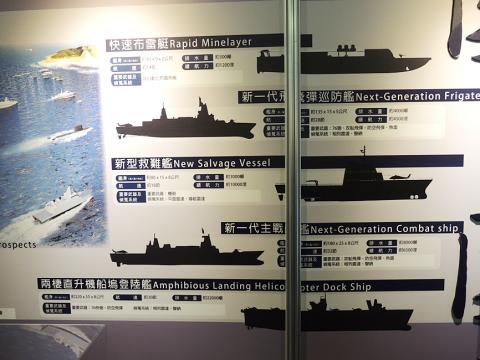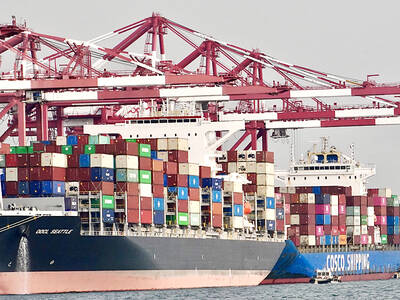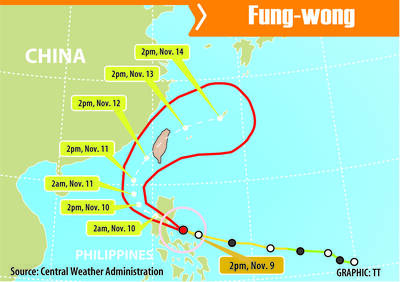The navy has proposed building a helicopter carrier as part of its indigenous shipbuilding program to boost the nation’s marine-patrol capabilities.
The navy plans to build a Landing Helicopter Dock capable of carrying six large helicopters and traveling at 30 knots (55kph).
The 22,000 tonne, 220m-long carrier would be fitted with an OTO Melara 76mm gun, an air defense missile system, an active electronically scanned array radar and advanced sonar system, the navy said.

Photo: Lo Tien-pin, Taipei Times
The announcement of the proposal coincided with a naval indigenous shipbuilding exhibition that opens today on the AOE 532 Panshi, a combat-support ship that docked in Keelung Harbor yesterday.
It is the first public presentation of the project since the navy unexpectedly scrapped its helicopter carrier plans from a program unveiled during the Kaohsiung International Maritime and National Defense Exhibition last year.
However, the navy said the plan is yet to be formally included in its shipbuilding scheme pending government approval.
“The presentation shows the navy’s ‘vision’ for a helicopter carrier, but whether it becomes a reality depends on government evaluations,” the navy said.
The navy has also planned to build rapid minelayers, salvage vessels, next-generation frigates and combat ships, minesweepers, submarines, amphibious dock vessels, multi-functional transport ships and more Tuo Jiang-class corvettes.
The Panshi sailed into the harbor yesterday along with a Cheng Kung-class frigate and a Kang Ding-class frigate, and is to be open to the public today and tomorrow from 9am to 3pm.
However, only Taiwanese with national ID cards are allowed to board the ships.
Meanwhile, Deputy Minister of National Defense Lee Hsi-ming (李喜明) rejected speculation that the government was planning to purchase a decommissioned Japanese submarine because the navy had difficulties building its first locally-designed submarine.
According to a Hong Kong media report, the ministry planned to purchase a retired Harushio-class or Oyashio-class diesel-electric submarine from Japan under the pretext of “importing scrap metal,” because the navy failed to secure the technology to build a submarine hull from the Netherlands, which built the navy’s two Chien Lung-class submarines, and other European countries.
“There is no such things and media speculation is incorrect,” Lee said.
The ministry was proceeding with the shipbuilding program, but much of the program is confidential and unsuitable for public discussion, he said.

The Central Weather Administration (CWA) yesterday said it expected to issue a sea warning for Typhoon Fung-Wong tomorrow, which it said would possibly make landfall near central Taiwan. As of 2am yesterday, Fung-Wong was about 1,760km southeast of Oluanpi (鵝鑾鼻), Taiwan’s southernmost point, moving west-northwest at 26kph. It is forecast to reach Luzon in the northern Philippines by tomorrow, the CWA said. After entering the South China Sea, Typhoon Fung-Wong is likely to turn northward toward Taiwan, CWA forecaster Chang Chun-yao (張峻堯) said, adding that it would likely make landfall near central Taiwan. The CWA expects to issue a land

Taiwan’s exports soared to an all-time high of US$61.8 billion last month, surging 49.7 percent from a year earlier, as the global frenzy for artificial intelligence (AI) applications and new consumer electronics powered shipments of high-tech goods, the Ministry of Finance said yesterday. It was the first time exports had exceeded the US$60 billion mark, fueled by the global boom in AI development that has significantly boosted Taiwanese companies across the international supply chain, Department of Statistics Director-General Beatrice Tsai (蔡美娜) told a media briefing. “There is a consensus among major AI players that the upcycle is still in its early stage,”

The Central Weather Administration (CWA) yesterday said it is expected to issue a sea warning for Typhoon Fung-wong this afternoon and a land warning tomorrow. As of 1pm, the storm was about 1,070km southeast of Oluanpi (鵝鑾鼻), Taiwan’s southernmost point, and was moving west-northwest at 28 to 32kph, according to CWA data. The storm had a radius of 250km, with maximum sustained winds of 173kph and gusts reaching 209kph, the CWA added. The storm is forecast to pass near Luzon in the Philippines before entering the South China Sea and potentially turning northward toward Taiwan, the CWA said. CWA forecaster Chang Chun-yao (張峻堯) said

PREPARATION: Ferry lines and flights were canceled ahead of only the second storm to hit the nation in November, while many areas canceled classes and work Authorities yesterday evacuated more than 3,000 people ahead of approaching Tropical Storm Fung-wong, which is expected to make landfall between Kaohsiung and Pingtung County this evening. Fung-wong was yesterday morning downgraded from a typhoon to a tropical storm as it approached the nation’s southwest coast, the Central Weather Administration (CWA) said, as it issued a land alert for the storm. The alert applies to residents in Tainan, Kaohsiung, Pingtung and Taitung counties, and the Hengchun Peninsula (恆春). As of press time last night, Taichung, Tainan, Kaohsiung, and Yilan, Miaoli, Changhua, Yunlin, Pingtung and Penghu counties, as well as Chiayi city and county had